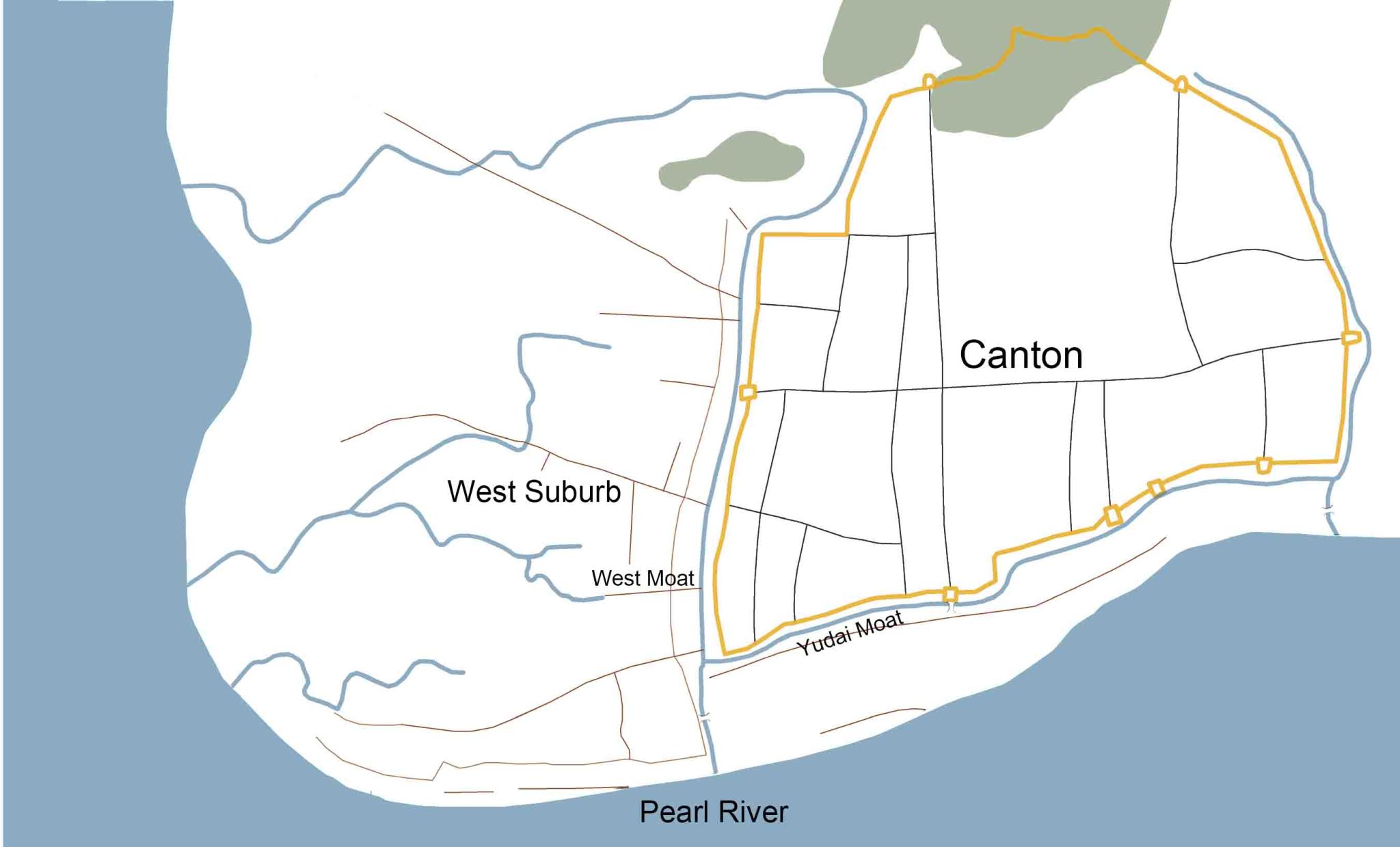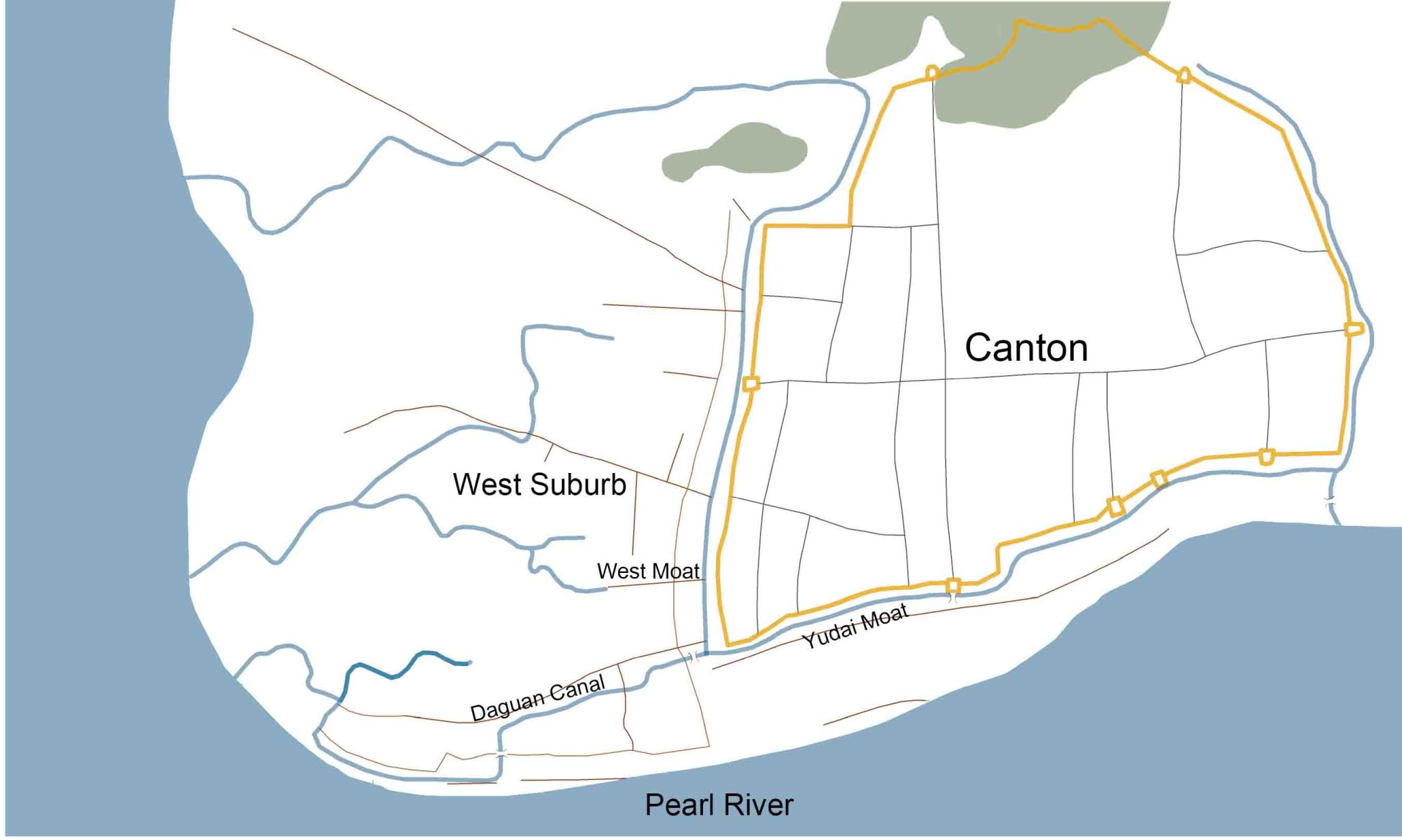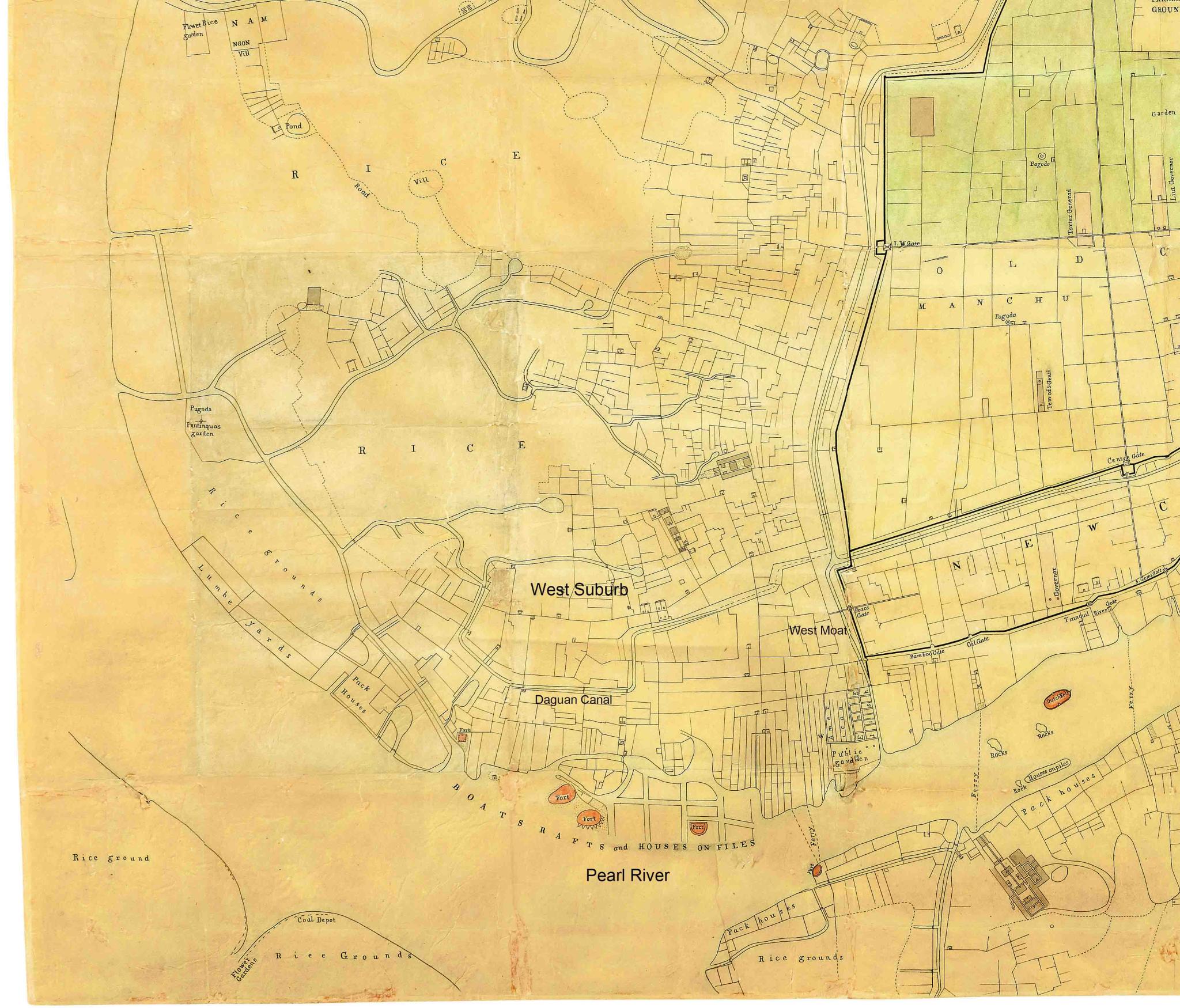Xueping Gu
In the free online course Water Works: Activating Heritage for Sustainable Development, learners make a portfolio addressing the spaces, transitions, challenges, stakeholders and values of a port city territory of their choosing. We motivate the learners to reflect on their learning and invite them to present their findings in a blog. In this blog, learner Xueping Gu writes about Daguan Canal in Canton to explain how the waterway and city interacted with each other throughout history. Canton (known as Guangzhou today) is the capital city of Guangdong Province, China. It is located at the estuary of the Pearl River, facing the South China Sea. This advantageous geographical location makes it an important port city. Daguan Canal was a waterway that was originally dug 500 years ago to connect the Pearl River and Canton city moat.
The Emergence of Daguan Canal
Canton was a cosmopolitan port city in China since the 16th century, being visited by large numbers of foreign navigators and explorers. The Portuguese for example arrived in Canton in 1517 and subsequently established trade links to the city. At that time, Canton experienced a business boom, leading to a series of commercial streets that arose between the Pearl River (珠江) and Yudai Moat (玉带濠) in the city. Ships with commodities had to go through the West Moat (西濠) from Pearl River, to then turn right and reach the commercial streets nearby the Yudai Moat. This meant that the city relied on inland canals for transport to the business center, rather than the wide, windy and dangerous Pearl River (see Figure 1).
Daguan Canal was dug in 1526, due to the rapid current at the estuary of the West Moat, which increased risks for ships. The canal was planned to connect the Yudai Moat in the east, then go through the west suburb Xiguan, join Liubo Creek (柳波涌) and finally flow into the Pearl River (see Figure 2). This project was completed with a canal more than 1300 meters long, 4 meters deep and 23 meters wide. Melchior Nunes Barreto, a Portuguese Jesuit priest who visited Canton in 1555 spoke of the infrastructure works as follows: “Almost everywhere around the city walls was navigable, because they made a canal from the river” (Loureiro 1997, p.63). Daguan Canal substantially promoted the development of the West Suburb which it traversed. Bridges and markets were built along the waterway, and shopkeepers and itinerant traders flocked to the area. This previously underdeveloped urban area subsequently turned into a navigable and prosperous place, and then continuously upgraded to become the city’s commercial center for centuries. Most of the foreign trade goods, including silk products, porcelains, Cantonese furniture and ivory carvings, were concentrated in the streets of the West Suburb (see Figure 3).



The Declines of Daguan Canal
After the 18th century, the Pearl River became the city’s main channel and commercial space therefore moved to the riverside. Ships stopped navigating into the inland canals, leading to the decline of Daguan Canal. At the same time, Daguan Canal was silted up and encroached by buildings, resulting into a narrower, 5.3 meters wide waterway, which only could be crossed by smaller sampan boats. Daguan Canal started to function as a drainage and transportation channel for the residents of the West Suburb. In order to dredge the canal periodically, residents set up the Dredging Canal Office (清濠公所) and Wenlan Academy (文澜书院) to organize the dredging works and raise funding. With the dredging works of Daguan Canal, citizens in the West Suburb created a management organization that gradually gained power on most local affairs, not only the canals (see Figure 4). Due to recovering economic vitality and community cohesion, the territory around Daguan Canal gradually developed again into an area with a prosperous urban culture. Some cultural heritage sites and practices, such as Guangdong Opera, the Flower Market and lion dances, were transmitted and promoted again in the urban daily life at this time.

From the 20th century onwards, however, Canton experienced rapid modern transformations. Old city walls were torn down in 1918 and replaced by an encircling modern road. Canton carried out building a great number of modern roads between 1918 and 1932, thereby shifting dominant transportation from water to land. Because of this, Daguan Canal completely lost its urban transportation function. The canal silted up quickly and got covered by slabs, leading to its disappearance from the city map.
The Revival of Daguan Canal
Because of the expansion of Canton city during the modern era, Xiguan (the West Suburb), which functioned as a commercial center hundreds of years ago as triggered by Daguan Canal, became an old and fading area. People nevertheless tried to revive this part of the old city by recovering the canals (see figure 5). A part of Daguan Canal has been recovered by uncovering the slabs, cleaning up sludge, tearing down encroaching houses and improving infrastructure. The uncovered canal quickly attracted new urban regeneration projects to settle along it as well, including Guangdong Opera Museum and Yongqing Fang. Guangdong Opera Museum was built for protecting the urban cultural heritage of Guangdong Opera, and designed in a garden style that could blend with the scenery of the canal. Yongqing Fang was a declining neighborhood block and planned to be revived by urban micro-renovations, which promoted the protection of the block’s architectural characteristics and community culture. Subsequently, Yongqing Fang became a hub for the promotion of urban cultural heritage. Many workshops on Canton embroidery, Canton porcelain, Canton furniture and carvings have been set up in the block and attract large numbers of visitors. Both Guangdong Opera Museum and Yongqing Fang have become popular tourist hotspots along the canal (see Figure 6). They take advantage of the urban culture that arose around the territory of Daguan Canal hundreds of years ago, and integrate urban revalidation with the aims to protect space and cultural heritage. However, at present, two thirds of the canal still remains covered up, and new proposals to further revive the riversides are still under discussion by authorities, planners and citizens. From the present moment, we can see that, although it has been 500 years since the emergence of Daguan Canal, the canal still plays an important role in local urban regeneration.
Conclusion: Waterway and City
The development of Daguan Canal shows the strong connection between waterway and city. In the very beginning, the increasing foreign trade in Canton motivated the proposal of digging a new canal. Because of Daguan Canal, the West Suburb developed into a commercial center. While inland waterways were replaced by the Pearl River, Daguan Canal silted up and became narrow. People in the West Suburb organized to dredge the canal and promoted the rise of urban social organization. At last, the modernization of Canton city caused the decline of local waterways, leading to Daguan Canal getting covered up and disappearing. As people try to revive the old city nowadays, Daguan Canal continues to play an important local role. The story of Daguan Canal therefore reveals the historical symbiosis between waterway and city: once the water space emerged, it rose and fell together with the city’s development.
Acknowledgement
The free online course Water Works: Activating Heritage for Sustainable Development runs on the edX platform. This blog has been written in the context of discussions in the LDE PortCityFutures research community. It reflects the evolving thoughts of the author and expresses the discussions between researchers on the socio-economic, spatial and cultural questions surrounding port city relationships. This blog was reviewed and edited by Kaiyi Zhu and Vincent Baptist.
References
Loureiro, R. M. (1997). In Search of the Origins of Macau. Maritime Museum of Macau.
